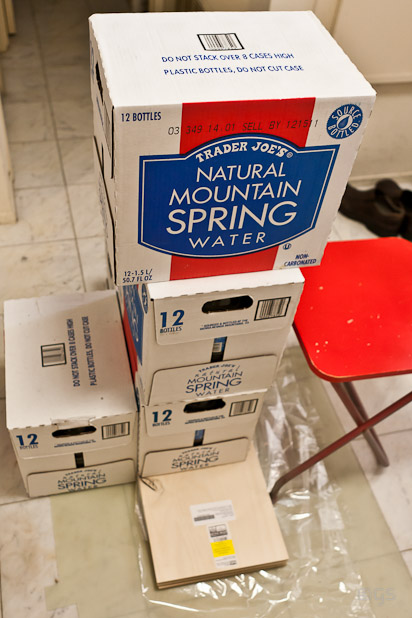Yesterday started cloudy but windless on the lakebed. I quickly prepped my newly-stable Squat rocket for the drag race my friend
KO and I had planned. She was stuck in traffic so I then prepped and flew my Dark Star Lite with the new
CTI H410 Vmax motor. That thing is insanely fast!! The following two shots were taken 1/8th of a second apart at 1/800th of a second shutter speed. Note the excessive motion blur on the second shot:


And I've zoomed in on the very cool glow of the motor ignition here about one millisecond after ignition. Vmax propellant is very efficient and barely visible were it not for the blast plate accumulation:
KO finally overcame the ridiculous I-15N traffic and prepped her Cheshire-style Squat. As I mentioned in my LDRS report below these kits are unstable with 54mm 1-grain motors unless one adds at least 8 oz of weight to the nose tip. KO and I used Crazy Glue's
Plastic Fusion epoxy to bond the lead into the polyethylene nosecone. According to their claims this should have worked except that, as I we walked up to the RSO table, I heard a clunk and knew my weight had slipped out of the nose tip. For the second time I can't fly my damned Squat!! KO decided to fly hers on a
CTI I140 Skidmark anyway in the hope that her nose weight would stay in place:


Well her flight started straight as you can see but then the weight slipped, the flight went unstable, and the rocket looped about five times before hitting the ground. Luckily she built hers well and it survived the impact with only cosmetic damage. Lesson learned: only the expensive
3M DP 8005 resin will truly stick stuff to polyethylene and polypropylene! You can use regular epoxy but you must use
expanding foam to hold that mass in place. Stupid inert polymers!
The wind started kicking up after noon but I prepped my bullet for an
AT J340 Metalstorm flight anyway. This motor is Aerotech's first foray into sparky motors and they've elected to back the flaming titanium chunks with white smoke rather than black. They also demo'd their Skidmark equivalent called 'Dark Metal' at LDRS so those'll be cool. One can never incinerate too much loud, impressive elemental titanium in one flight. All of my flights seem to drift well beyond all others independent of wind level. Today, however, this particular flight landed within 100' of the pad and that's some serious luck!:

I also shot a few sequences with the intent of stitching together a virtual drag race in Photoshop. Normall I don't like sooty Blackjack/Smoky Sam motors but the wide-angle perspective of this frame intrigues me so I shared it in isolation here:

Finally Frank Hermes brought his dog River out so I could get my yellow Lab fix. He's a good buddy and I thank him for braving the 100˚F heat!




















































